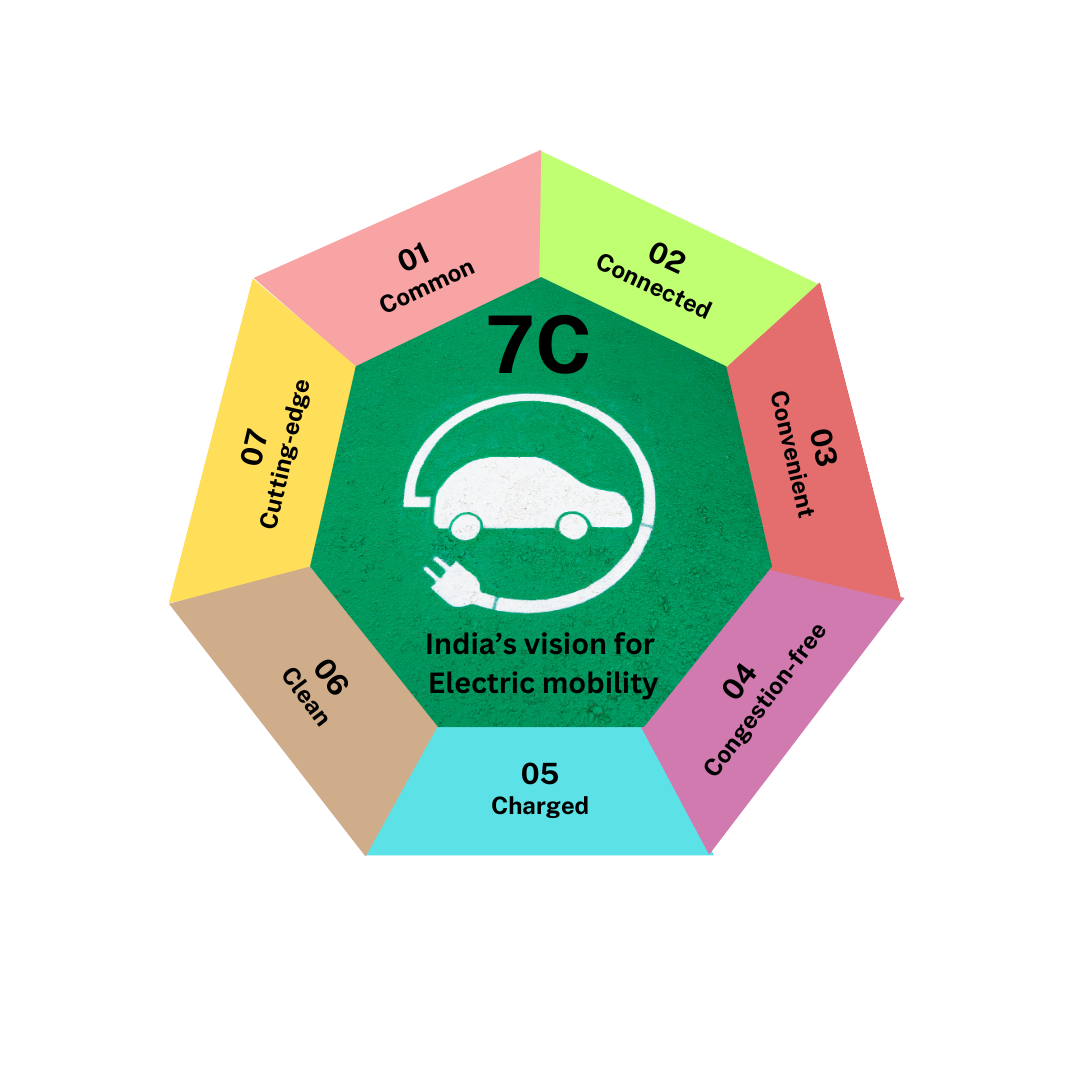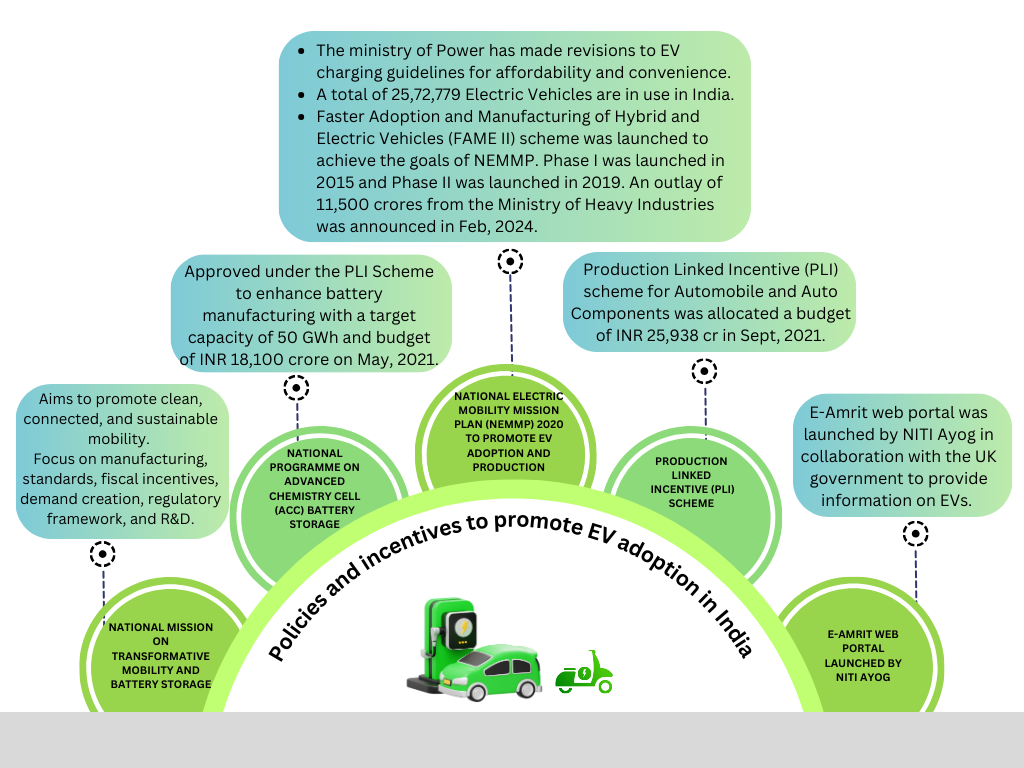July 25 , 2024
From Wheels to Watts: Technology for a Zero-Emission Future
The Ministry of Heavy Industries allocated the FAME Scheme
(Phase II) an additional 1,500 crores in February 2024
India has plans to set up over 22,000 EV charging stations
across fuel stations by 2024
Reducing emissions from the transportation sector, a significant
contributor to urban pollution and greenhouse gases, is crucial
for environmental health. The transition to electric vehicles
(EVs) and other alternative fuel vehicles aims to achieve zero
or low carbon emissions. This shift not only focuses on cleaner
energy sources but also emphasizes the development of
affordable, accessible, and safe mobility solutions, marking a
significant step towards sustainable urban transportation.
Explore the transformation of the transportation sector with electric vehicles which is an essential stride towards a cleaner, zero-emission future.
Electric Mobility Initiatives:
Electric mobility is gaining momentum in India as a sustainable solution to environmental and economic challenges. The transportation sector being India’s third largest emitter, a shift towards electric vehicles (EVs) aims to reduce the country's reliance on oil imports, cut CO2 emissions and address serious health risks associated with air pollution.
India has implemented policies like the Faster Adoption and Manufacturing of Hybrid and Electric Vehicles (FAME) scheme and Production Linked Incentive (PLI) scheme to support this transition, encouraging domestic manufacturing and adoption of EVs, particularly in the public and private transport sectors. States have also drafted specific EV policies, and advancements such as falling battery costs and a battery swapping policy are making EVs more viable.
Challenges:
Achieving net zero necessitates profound transformations in our energy, industrial, and transportation sectors, urging top emitters to intensify their Nationally Determined Contributions (NDCs) and enact immediate emission reductions. The Nationally Determined Contributions (NDCs) are commitments made by countries to reduce their greenhouse gas emissions to mitigate climate change. These commitments outline the necessary policies and measures to achieve the global targets established in the Paris Agreement. NDCs play a crucial role in international climate efforts, as they specify each country's plans and actions to contribute to the collective goal of limiting global warming to well below 2°C, with efforts to limit it to 1.5°C. By implementing these contributions, countries aim to foster sustainable development while addressing the urgent need for climate action.
Progress towards net zero could potentially avoid 2.7°C of global temperature increase and avoid 24 gigatons of additional carbon dioxide emissions by 2050 (International Energy Agency)
-
EVs require a higher initial investment compared to internal combustion engines, which can dissuade buyers.
-
The lack of extensive charging infrastructure and the consequent "range anxiety" are significant hurdles. Range anxiety is frequently mentioned as an obstacle to the broader adoption of electric vehicles.
-
Additionally, the electric grid needs substantial upgrades to handle the increased load from EVs.
While the momentum towards electric mobility is positive, addressing these challenges is crucial for India to fully leverage the environmental and economic benefits of EVs.
Policies and incentives to promote EV adoption:
India's vision for future mobility is articulated around the seven principles known as the 7C's: Common, Connected, Convenient, Congestion-free, Charged, Clean, and Cutting-edge.
By 2030, the Indian government aims for 30% of private cars, 70% of commercial vehicles, and 80% of two and three-wheelers to be electric

To advance the vision of 7C, the National Mission on Transformative Mobility and Battery Storage was established, targeting a comprehensive policy framework that promotes clean, sustainable mobility across the country. The National Program on Advanced Chemistry Cell (ACC) Battery Storage under the PLI Scheme, aiming for a 50 GWh manufacturing capacity with an INR 18,100 crores budget was announced in May 2021. The PLI scheme for Automobile and Auto Components, with an INR 25,938 crores outlay was announced to further support EV adoption in September 2021. This program has selected four companies for incentives to boost local battery production.
The Ministry of Power has revised guidelines to make EV charging more affordable and accessible, allowing EV owners to use existing electricity connections for charging at home or work. The FAME Scheme Phase II was allocated an additional INR 1,500 crores to an earlier budget of INR 10,000 crores in 2019 by the Ministry of Heavy Industries in February 2024. As of now, India has 25,72,779 registered electric vehicles. The National Electric Mobility Mission Plan (NEMMP) 2020 and the E-Amrit portal by NITI Aayog are other crucial steps towards enhancing EV adoption and production.

In 2021, the Ministry of Road Transport and Highways (MoRTH), announced that by 2030, the government aims to achieve an electric vehicle (EV) sales penetration of 30% for private cars, 70% for commercial vehicles, and 80% for two and three-wheelers.
Care Edge Ratings report a notable shift away from traditional fuel vehicles, noting that petrol vehicle sales decreased from 86% in 2020 to 76% in 2023. During the same period, sales of alternative fuel vehicles surged by 400%. Electric vehicles (EVs) are now known for having the lowest lifetime costs, closely followed by CNG vehicles. This move towards alternative fuels is supported by falling battery prices, increasing fuel costs, and government incentives such as the FAME-II scheme, which recently got a funding boost of INR 1,500 crore to encourage EV adoption.
By 2030, it is anticipated that fuel demand will decrease as electric vehicle (EV) technologies stabilize. In response, refiners are planning to invest in petrochemical integration to adapt to the changing market dynamics.
As of February 2, 2024, 12,146 public EV charging stations are operational across India, according to the Ministry of Power. To further support the growth of electric vehicles, the Indian government has ambitious plans to set up over 22,000 EV charging stations across fuel stations by 2024. This expansion is expected to significantly ease the adoption of EVs by reducing range anxiety among potential users.
On March 15, 2024, the Union Government approved a comprehensive scheme to promote India as a global manufacturing hub for electric vehicles (EVs), highlighting the country's commitment to enhancing its EV manufacturing capabilities. The scheme, which is a significant step under the "Make in India" initiative, is designed to attract investments from reputed global EV manufacturers, boosting local production and incorporating advanced technologies. This policy aims to stimulate investment, foster competition, and encourage economies of scale, which are expected to reduce production costs and advance India's manufacturing agenda.
New energy policies targeting reducing diesel use are focused on the trucking sector. Smaller trucks, which are pivotal in e-commerce and delivery services, are poised to be at the forefront of this transition due to their economic benefits and operational efficiencies.
India remains one of the fastest-growing oil markets worldwide, yet the country's embrace of electric vehicles (EVs) has been slower compared to its European and Asian counterparts. This is changing as recent investments in vehicle production and energy infrastructure begin to make a significant impact. Enhanced by government incentives such as tax breaks, these developments are crucial in fostering a robust EV ecosystem. These efforts are integral to India's broader strategy to shift towards more sustainable energy solutions.

